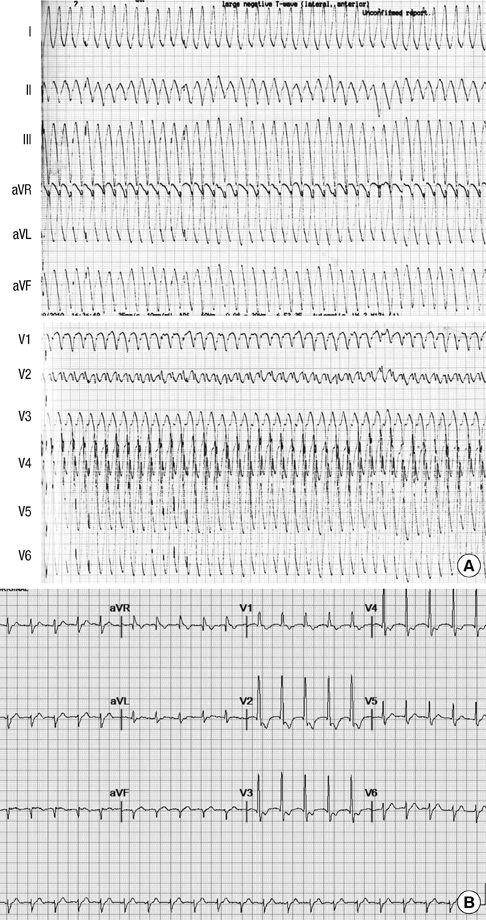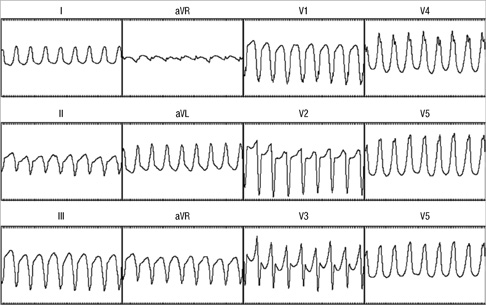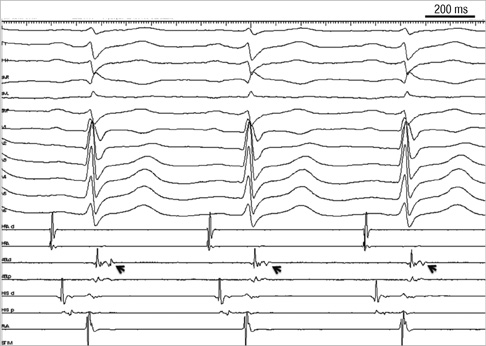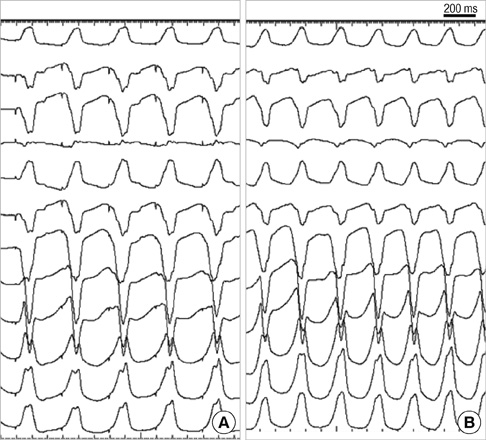J Korean Med Sci.
2012 Feb;27(2):215-217. 10.3346/jkms.2012.27.2.215.
Radiofrequency Catheter Ablation of Hemodynamically Unstable Ventricular Tachycardia Associated with Systemic Sclerosis
- Affiliations
-
- 1Cardiology Division, Department of Internal Medicine, Kyung Hee University College of Medicine, Seoul, Korea. jinbbai@khu.ac.kr
- 2Cardiology Division, Yonsei Cardiovascular Center and Cardiovascular Research Institute, Yonsei University College of Medicine, Seoul, Korea.
- KMID: 1120162
- DOI: http://doi.org/10.3346/jkms.2012.27.2.215
Abstract
- Systemic sclerosis (SS) is a connective tissue disease and cardiac involvement is common. Primary cardiac involvement such as conduction system disturbances and arrhythmias can also occur. However, reports of sustained ventricular tachycardia (VT) are rare. We report a case of catheter ablation of sustained ventricular tachycardia in a patient with systemic sclerosis using a conventional mapping system. A 64-yr-old woman with a 10-yr history of SS was referred for management of her ventricular tachycardia. There was no structural abnormality in cardiac chambers. However, electrophysiologic study revealed electrical substrate of ventricular tachycardia which could be ablated with pacemapping and substrate mapping. This case demonstrated successful conventional mapping and catheter ablation in a hemodynamically unstable patient with SS.
MeSH Terms
Figure
Reference
-
1. Lazzerini PE, Capecchi PL, Guideri F, Acampa M, Selvi E, Bisogno S, Galeazzi M, Laghi-Pasini F. Autoantibody-mediated cardiac arrhythmias: mechanisms and clinical implications. Basic Res Cardiol. 2008. 103:1–11.2. Yamamoto T. Scleroderma: pathophysiology. Eur J Dermatol. 2009. 19:14–24.3. Bulkley BH, Riodolfi RL, Salyer WR, Hutchins GM. Myocardial lesions of progressive systemic sclerosis. A cause of cardiac dysfunction. Circulation. 1976. 53:483–490.4. Roberts NK, Cabeen WR Jr, Moss J, Clements PJ, Furst DE. The prevalence of conduction defects and cardiac arrhythmias in progressive systemic sclerosis. Ann Intern Med. 1981. 94:38–40.5. Lazzerini PE, Capecchi PL, Guideri F, Acampa M, Galeazzi M, Laghi-Pasini F. Connective tissue diseases and cardiac rhythm disorders: an overview. Autoimmun Rev. 2006. 5:306–313.6. Kostis JB, Seibold JR, Turkeich D, Masi AT, Grau RG, Medsger TA Jr, Steen VD, Clements PJ, Szydlo L, D'Angelo WA. Prognostic importance of cardiac arrhythmias in systemic sclerosis. Am J Med. 1988. 84:1007–1015.7. Rankin AC, Osswald S, McGovern BA, Ruskin JN, Garan H. Mechanism of sustained monomorphic ventricular tachycardia in systemic sclerosis. Am J Cardiol. 1999. 83:633–636.8. Lacroix D, Brigadeau F, Marquié C, Klug D. Electroanatomic mapping and ablation of ventricular tachycardia associated with systemic sclerosis. Europace. 2004. 6:336–342.9. Rankin AC. Arrhythmias in systemic sclerosis and related disorders. Card Electrophysiol Rev. 2002. 6:152–154.10. Nakahara S, Tung R, Ramirez RJ, Michowitz Y, Vaseghi M, Buch E, Gima J, Wiener I, Mahajan A, Boyle NG, Shivkumar K. Characterization of the arrhythmogenic substrate in ischemic and nonischemic cardiomyopathy implications for catheter ablation of hemodynamically unstable ventricular tachycardia. J Am Coll Cardiol. 2010. 55:2355–2365.
- Full Text Links
- Actions
-
Cited
- CITED
-
- Close
- Share
- Similar articles
-
- Successful Treatment of Tachycardia-induced Cardiomyopathy with Radiofrequency Catheter Ablation
- Radiofrequency Catheter Ablation of Ventricular Tachycardia in Patients without Structural Heart Disease
- Intramural Reentrant Ventricular Tachycardia in a Patient with Severe Hypertensive Left Ventricular Hypertrophy
- The Role of Intravenous Dopamine on Hemodynamic Support during Radiofrequency Catheter Ablation of Poorly Tolerated Idiopathic Ventricular Tachycardia
- Catheter ablation for treatment of tachyarrhythmia





